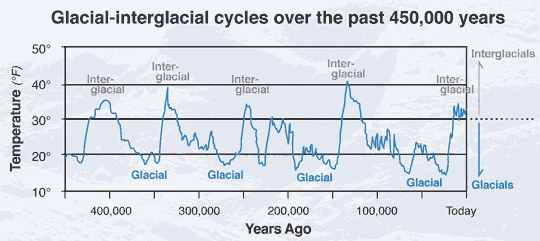
Today we’re continuing on our discussion of evolution via natural selection. While the fundamental principle of natural selection is easy to comprehend, its ramifications are not. After all, it’s easy to explain that water can cause erosion. It’s much harder to explain that erosion can make the Grand Canyon.
And in much the same way, it’s easy to explain that environmental pressure can change skin color and hair color in humans. It’s much harder to explain how we came from small, lizard-like animals.

So how does it work? How does evolution go from seemingly minor adaptations to massive, species-changing differences?
The answer is time.
A Question of Scale(s)
Allow me to paint a picture for you. People tend to produce a new “generation” of kids about once every 25 years. That means 4 generations every 100 years.
- Europeans adventured to the Americas during the 1500s. That’s about 20 generations. Ok, not too long ago.
- Humans invented the compass in the 200 BCE, or 2200 years ago. That’s 88 generations. That’s quite a bit of time, but believable.
- The Sphinx was built around 2500 BCE, or 4,500 years ago. That’s 180 generations. That’s a lot!
- The paintings on the walls of the Lascaux cave in France were made around 20,000 years ago. That’s 800 generations. Wow.
- Anatomically-modern human fossils appeared in Africa around 200,000 years ago. That’s 8,000 generations.
In other words, in order to make a genealogy tree extending all the way back to the first humans, you would need a family tree with (at least) 8,000 rows, spanning 200,000 years. And 200,000 years? That’s nothing. At this point, generations becomes meaningless because we are now looking at different species. Let's continue!
Our predecessors belonged to a species named “Homo erectus,” which is Latin for “Upright Man.” They first appear in the fossil records about 2 million years ago. Their species lived 10x as long as ours has.
Before them were the Australopithicines, starting about 4 million years ago.
We broke off from our closest living relatives, chimpanzees and bonobos, nearly 7 million years ago.
And we haven’t even come close to the Jurassic period, which ended 145 million years ago. The diagram below should help illustrate just how little time we have spent on this planet.

Image Courtesy of Wikipedia.
So What’s Your Point?
My point is, when we think about speciation and evolution, we need to start thinking BIG. Humans have only been around for a tiny fraction of Earth’s history. We have discovered a lot, but there is still plenty more to discover.
In this way, geology actually shaped how we think about biology. Darwin saw his colleagues in geology realizing just how old the Earth was. When he started to think about the time involved in geology, evolution leading to speciation made significantly more sense. Small changes, when added up over time, amount to very large changes.
Darwin first developed the model of “gradualism” to explain speciation. He suggested that species change very slowly over time, and these accumulated changes lead to new species. Given the evidence available to him at the time, this is a very reasonable model.
However, modern evidence suggests that gradualism isn’t entirely accurate. As it turns out, sometimes fossils can transition “rapidly” into new species (and by rapidly, we mean 100,000 years or so). This can happen as a response to when the environment and selective pressures change rapidly. This new model is called “punctuated equilibrium.” It’s defined by long periods of relatively few changes, punctuated by rapid changes in response to the environment.

This model fits the appearance of humans around 200,000 years ago. We appeared right at the beginning of an ice age, when the Earth was relatively cold. Species were going extinct, and we changed in response. We survived the subsequent ice age, and then spread across the world.

Image courtesy of Utah Geological Survey
Tying It All Up
Well, we went on a major tangent, talking about us humans. So egocentric!
The honest truth is that if we want to talk about genetics, we need to think of time scales where countries didn’t even exist. We’re talking about tribes, not nations. While it is always fun to tell others what percentage French or English you are, these countries didn’t even exist 1,000 years ago, less than 40 generations. Most haplogroups go back tens of thousands of years, or even further.
Remember: Think BIG.
References:
- https://www.nps.gov/grca/learn/nature/geologicformations.htm
- http://www.prehistoric-wildlife.com/species/a/archaeothyris.html
- http://www.historyofcompass.com/
- https://www.history.com/news/how-old-is-the-great-sphinx
- https://web.archive.org/web/20090218063731/http://www.dorlingkindersley-uk.co.uk/nf/Book/BookDisplay/0%2C%2C9781405320931%2C00.html?%2FEgypt
- http://www.bradshawfoundation.com/lascaux/
- http://humanorigins.si.edu/evidence/human-fossils/species/homo-sapiens
- http://humanorigins.si.edu/evidence/human-fossils/species/australopithecus-afarensis
- https://www.livescience.com/3996-humans-chimps-split.html
- https://studyres.com/doc/16271875/types-of-evolution--punctuated-equilibrium-vs-gradualism
- https://geology.utah.gov/map-pub/survey-notes/glad-you-asked/ice-ages-what-are-they-and-what-causes-them/



